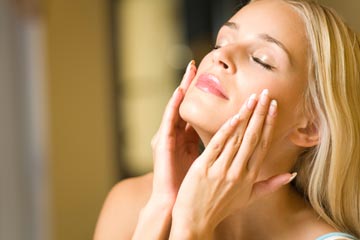Aging, and the adverse effect it has on your skin, is inevitable. Crow’s feet — or “laugh lines” or “character lines” — are simply wrinkles that begin forming at the outside corners of your eyes, typically in your mid-20s. They may show up earlier if you don’t take care of you skin, and later if you do.
Either way, crow’s feet and other wrinkles are unavoidable, because as we age, our bodies lose their natural elasticity. Skin wrinkles and certain parts of our body droop. One of the main reasons for this is that our bodies’ production of collagen and elastin — two proteins responsible for our skin’s elasticity — diminishes. But you don’t have to capitulate completely to Father Time. Here’s how:
- Steer clear of the sun and smoking: For starters, you can help avoid crow’s feet by protecting yourself from the sun’s harmful UV rays by using a high-SPF sunscreen. Exposure to UV rays is one of the most common ways our skin loses collagen and elastin, and ultimately, its ability to bounce back. If you’re a smoker, you’re placing your skin at double jeopardy, since smoking accelerates the biochemical processes that cause your skin to age faster.
- Try a cream: Some over-the-counter moisturizing creams — when used regularly — will diminish the appearance of crow’s feet, but are unlikely to actually prevent wrinkles or restore your skin’s elasticity. Use creams that contain active agents like retinoids, alpha hydroxy acids and copper peptides, the same ingredients prescription wrinkle creams contain in higher doses. If nonprescription creams aren’t helping, a dermatologist might suggest something with a greater concentration of active ingredients. While some wrinkle creams may seem expensive, they are generally cheaper than cosmetic surgery and procedures like Botox, and, over the long run, may provide acceptable results.
- Consider Botox: Crow’s feet are most pronounced when you work the muscles around your eyes, such as smiling, laughing or squinting. Botox — short for botulinum toxin injections — chemically relaxes those muscles so they can’t contract. Though Botox treatments are FDA approved and generally safe, they can result in complications if the toxin spreads, so you should only receive injections from a certified physician. The upside of Botox is that it only takes a few minutes. The downside? It involves needles, it isn’t cheap and it doesn’t last. It may take up to a week to see any results, and those can last anywhere from three to six months.
- Go natural: There are many natural cures to crow’s feet as well, such as home remedies containing vitamin E. The first is a recipe including flaxseed oil, and all you have to do is swallow it. The oil contains vitamin E — as well as vitamins B and C — and has numerous additional health benefits. Or you could simply poke a small hole in a vitamin E tablet and carefully apply the contents to the area surrounding your eyes. Egg white facemasks are also popular. Apply an egg white to your entire face, and let it dry thoroughly. Afterward, wash it off with warm water and gently dry your face. This will tighten your skin, reducing the appearance of crow’s feet.
- Eat right: Another simple cure for crow’s feet is your diet. Foods rich in antioxidants, like eggplant, asparagus, fish and olive oil, can play a role in protecting the skin. Conversely, some foods — like full-fat milk — may increase the odds that you’ll develop wrinkles. However, drinking plenty of pure water every day will help by ensuring your body’s moisture levels are adequate. Keeping your weight under control is another big benefit. When we gain weight, we gain it in our faces, which stretches out the skin. Constant fluctuations can continually stretch the skin, making it more likely to wrinkle.
While you’re likely to notice crow’s feet at some point in your life, don’t fret. There are plenty of options to reduce their appearance. Read on to find out lots more information about getting rid of crow’s feet.
Related Articles
- 10 Home Remedies for Wrinkles
- Fact or Fiction: Wrinkles
- Botox: What You Need to Know
- Microdermabrasion Overview
- 5 Tips for Smoother Skin
Sources
- The American Academy of Dermatology. “Causes of Aging Skin.” (Aug. 4, 2009) http://www.skincarephysicians.com/agingskinnet/basicfacts.html
- The American Academy of Dermatology. “10 Tips: Selecting Age-Fighting Topicals.” June 17, 2009. (Aug. 4, 2009) http://www.skincarephysicians.com/agingskinnet/age_fighting_selecting.html
- The American Academy of Dermatology. “Botulinum Rejuvenation.” (Aug. 4, 2009) http://www.skincarephysicians.com/agingskinnet/botulinum_rejuvenation.html
- The American Society for Aesthetic Plastic Surgery. “Nearly 6.9 Million Cosmetic Procedures in 2002.” March 4, 2003. (Aug. 5, 2009) http://www.surgery.org/press/news-release.php?iid=530 Corresponding stats: http://www.surgery.org/download/2002%20stats_403.pdf
- Emmerson, Kassidy. “Homemade Treatments for Crow’s Feet.” Associated Content. Apr. 20, 2007. (July 11, 2009) http://www.associatedcontent.com/article/211421/homemade_treatments_for_crows_feet_pg2.html?cat=68
- Mayo Clinic. “Botox Injections.” Aug. 2, 2008. (July 11, 2009) http://www.mayoclinic.com/print/botox/MY00078/METHOD=print&DSECTION=all
- Mayo Clinic. “Wrinkles” Jan. 27, 2009. (Aug. 4, 2009) http://www.mayoclinic.com/health/wrinkles/DS00890
- Mayo Clinic. Q&A “Are Some Foods Better than Others for Healthy Skin?”http://www.mayoclinic.com/health/healthy-skin/AN01863
- Paramapoonya, Om. “Myths and Facts about Wrinkles.” (July 11, 2009) http://hubpages.com/hub/anti-aging
- Saint Louis, Catherine. “The Anti-Wrinkle Challenge” New York Times. April 2, 2009. (Aug. 4, 2009) http://www.nytimes.com/2009/04/02/fashion/02SkinSide.html
- The Beauty Insiders. “LifeCell.” (July 11, 2009) http://www.thebeautyinsiders.com/lifecell.html
- “Vitamin E.” April 16, 2008. (Aug. 4, 2009) http://www.webmd.com/vitamins-lifestyle-guide/supplement-guide-vitamin-e
- “Cosmetic Procedures: Botox.” March 1, 2007. (Aug. 4, 2009) http://www.webmd.com/skin-beauty/guide/cosmetic-procedures-botox
